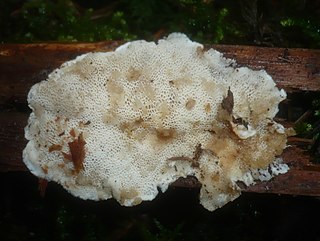
An arbuscular mycorrhiza (AM) is a type of mycorrhiza in which the symbiont fungus penetrates the cortical cells of the roots of a vascular plant forming arbuscules. Arbuscular mycorrhiza is a type of endomycorrhiza along with ericoid mycorrhiza and orchid mycorrhiza .They are characterized by the formation of unique tree-like structures, the arbuscules. In addition, globular storage structures called vesicles are often encountered.

The Pluteaceae are a family of small to medium-sized mushrooms which have free gill attachment and pink spores. Members of Pluteaceae can be mistaken for members of Entolomataceae, but can be distinguished by the angled spores and attached gills of the Entolomataceae. The four genera in the Pluteaceae comprise the widely distributed Volvariella and Pluteus, the rare Chamaeota, and Volvopluteus, which was newly described in 2011 as a result of molecular analysis. The Dictionary of the Fungi estimates there are 364 species in the family.

The Tremellomycetes are a class of dimorphic fungi in the Agaricomycotina. Some species have gelatinous basidiocarps or (microscopically) a sacculate parenthesome. There are six orders, 17 families, and 39 genera in the Tremellomycetes. Tremellomycetes include yeasts, dimorphic taxa, and species that form complex fruiting bodies. Tremellomycetes include some fungi that are human and animal pathogens in the genera Cryptococcus, Naganishia, Papiliotrema, and Trichosporon and some fungi that are cultivated for food in the genera Tremella and Naematelia.

A fungus is any member of the group of eukaryotic organisms that includes microorganisms such as yeasts and molds, as well as the more familiar mushrooms. These organisms are classified as one of the traditional eukaryotic kingdoms, along with Animalia, Plantae and either Protista or Protozoa and Chromista.

The Tremellales are an order of fungi in the class Tremellomycetes. The order contains both teleomorphic and anamorphic species, most of the latter being yeasts. All teleomorphic species in the Tremellales are parasites of other fungi, though the yeast states are widespread and not restricted to hosts. Basidiocarps, when produced, are gelatinous.
The Cuniculitremaceae are a family of fungi in the order Tremellales. There are three genera in the family. Sterigmatosporidium polymorphum parasitizes other fungi growing in insect galleries in wood. It does not produce basidiocarps, but has septate basidia similar to those found in the genus Tremella. Most species are known only from their yeast states.

The Agaricostilbomycetes are a class of fungi in the subdivision Pucciniomycotina of the Basidiomycota. The class consists of a single order, six families, and 15 genera. Its type genus, Agaricostilbum was originally placed in Ascomycota, and later, Agaricomycotina, before being placed in Pucinniomycotina.

The Microbotryomycetes are a class of fungi in the subdivision Pucciniomycotina of the Basidiomycota. The class currently contains eight orders, plus three additional, unassigned families, plus seven additional, unassigned genera. Many species are known only from their yeast states. Species with hyphal states typically produce auricularioid basidia and are often parasitic on other fungi or plants. Several species in the genera Rhodotorula and Sporobolomyces are opportunistic human pathogens.
The Filobasidiaceae are a family of fungi in the order Filobasidiales. Most species are yeasts, but some form gelatinous fruit bodies that are parasitic on other fungi, including lichens. The family currently contains five genera.
Filobasidium is a genus of fungi in the family Filobasidiaceae. Most species are only known from their yeast states, but some produce hyphae with haustorial cells, indicating that they are parasites of other fungi. Basidia are tubular with terminal, sessile basidiospores. Basidiocarps are not formed.
The Leucosporidiales are an order of fungi in the class Microbotryomycetes. The order contains a single family, the Leucosporidiaceae, which in turn contains a single genus, Leucosporidium. The order comprises fungi that are mostly known from their yeast states, though some produce hyphal states in culture that give rise to teliospores from which auricularioid basidia emerge.
The Chionosphaeraceae are a family of fungi in the order Agaricostilbales. The family contains six genera. Some species form small, stilboid (pin-shaped) fruitbodies. Others are known only from their yeast states.

Mucoromycota is a division within the kingdom fungi. It includes a diverse group of various molds, including the common bread molds Mucor and Rhizopus. It is a sister phylum to Dikarya.
The Cryptococcaceae are a family of fungi in the order Tremellales. The family currently contains two genera. Some species produce filamentous, sexual states with distinctive basidia and are parasites of other fungi. Most, however, are only known from their yeast states. Several species of Cryptococcus are human pathogens.
The Bulleraceae are a family of fungi in the order Tremellales. The family currently contains five genera. Some species produce gelatinous basidiocarps and were formerly placed in the genus Tremella. Most, however, are only known from their yeast states.
The Bulleribasidiaceae is a family of fungi in the order Tremellales.
The Piskurozymaceae are a family of fungi in the order Filobasidiales. Most species are only known from their yeast states, but some produce filamentous sexual states with basidia that are parasitic on other fungi. The family currently contains two genera.
The Rhynchogastremaceae are a family of fungi in the order Tremellales. The family currently contains two genera. Some species produce filamentous sexual states with septate basidia and are parasites of other fungi. Most, however, are only known from their yeast states.
The Tetragoniomycetaceae are a family of fungi in the order Trichosporonales. The family currently contains four genera. Several species are only known from their yeast states.

The Carcinomycetaceae are a family of fungi in the order Tremellales. The family currently contains a single genus. Some species produce filamentous sexual states with basidia and are parasites of other fungi. Some, however, are only known from their yeast states.








